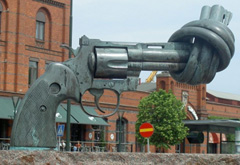 In recognition of the increasing impact television has on decision-making by bringing world attention to conflicts and threats to peace and security and its potential role in sharpening the focus on other major issues, including economic and social issues, the United Nations General Assembly proclaimed 21 November as World Television Day (through resolution 51/205 of 17 December 1996).
In recognition of the increasing impact television has on decision-making by bringing world attention to conflicts and threats to peace and security and its potential role in sharpening the focus on other major issues, including economic and social issues, the United Nations General Assembly proclaimed 21 November as World Television Day (through resolution 51/205 of 17 December 1996).
World Television Day is not so much a celebration of the tool, but rather the philosophy which it represents. Television represents a symbol for communication and globalization in the contemporary world.
On 21 and 22 November 1996 the United Nations held the first World Television Forum, where leading media figures met under the auspices of the United Nations to discuss the growing significance of television in today’s changing world and to consider how they might enhance their mutual cooperation. That is why the General Assembly decided to proclaim 21 November as World Television Day.
This was done in recognition of the increasing impact television has on the process of decision-making. Television was thus acknowledged as a major tool in informing, channelling and affecting public opinion. Its impact and presence and its influence on world politics could not be denied.
Source: Text: UN Image: Freepik
 This is the meaning of the apostle Paul in the 2nd reading of this Sunday (5th Sunday, Year A).
This is the meaning of the apostle Paul in the 2nd reading of this Sunday (5th Sunday, Year A). Mahatma Gandhi used. Gandhi was born in India on October 2, 1869. He is remembered today for his contributions towards India’s freedom and for sharing with the world a doctrine for dealing with injustice and disharmony. He taught people the philosophy of Ahimsa, which encourages the use of non-violence as a tool for the peaceful resolution of differences. India gained its freedom on August 15, 1947, through Gandhi’s efforts. He was assassinated on January 30, 1948.
Mahatma Gandhi used. Gandhi was born in India on October 2, 1869. He is remembered today for his contributions towards India’s freedom and for sharing with the world a doctrine for dealing with injustice and disharmony. He taught people the philosophy of Ahimsa, which encourages the use of non-violence as a tool for the peaceful resolution of differences. India gained its freedom on August 15, 1947, through Gandhi’s efforts. He was assassinated on January 30, 1948. The UN General Assembly came up with a resolution in 2007 to establish the International Day of Non-Violence. The day aimed to spread the message of non-violence, including through education and public awareness, around the world. The resolution reflected universal respect for Gandhi and his philosophy. October 2, which is Gandhi’s birthday, was allocated as the day’s date. The first International Day of Non-Violence was on October 2, 2007.
The UN General Assembly came up with a resolution in 2007 to establish the International Day of Non-Violence. The day aimed to spread the message of non-violence, including through education and public awareness, around the world. The resolution reflected universal respect for Gandhi and his philosophy. October 2, which is Gandhi’s birthday, was allocated as the day’s date. The first International Day of Non-Violence was on October 2, 2007.
 The first World Television Forum was staged by the United Nations in the mid ’90s, and it was out of this event that World Television Day was born. The forum brought together leading figures from the media industry to analyze the growing impact that TV had on decision-making and public opinion when it comes to issues of peace and security around the planet.
The first World Television Forum was staged by the United Nations in the mid ’90s, and it was out of this event that World Television Day was born. The forum brought together leading figures from the media industry to analyze the growing impact that TV had on decision-making and public opinion when it comes to issues of peace and security around the planet. The International Day of Non-Violence is marked on 2 October, the birthday of Mahatma Gandhi, leader of the Indian independence movement and pioneer of the philosophy and strategy of non-violence.
The International Day of Non-Violence is marked on 2 October, the birthday of Mahatma Gandhi, leader of the Indian independence movement and pioneer of the philosophy and strategy of non-violence.